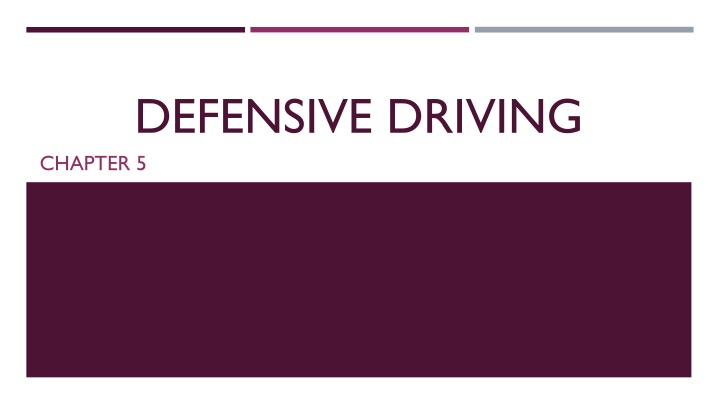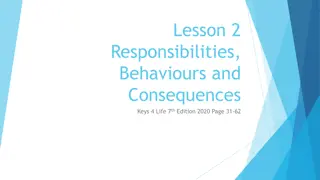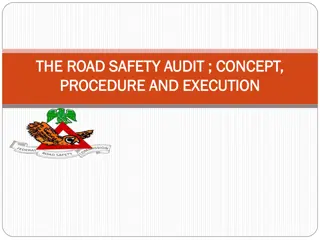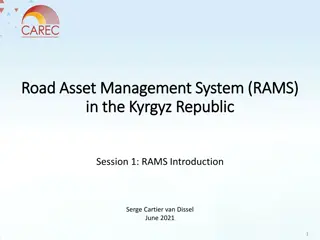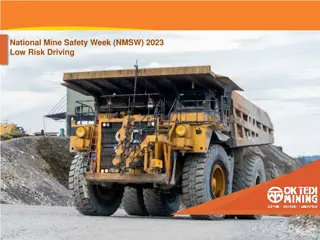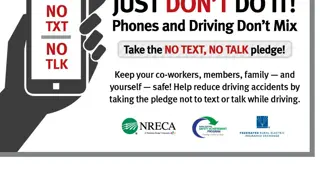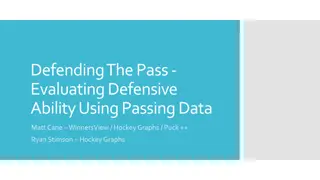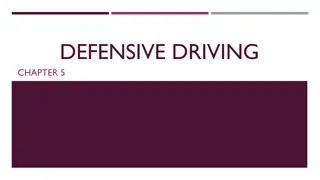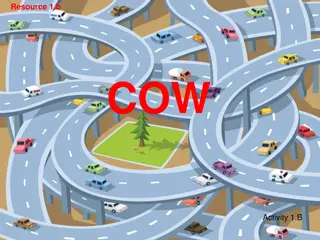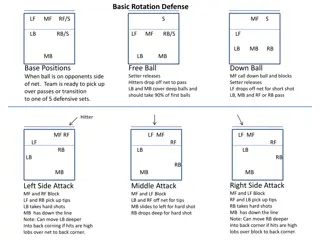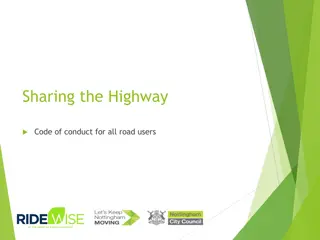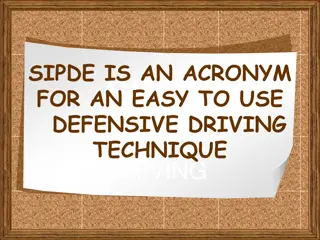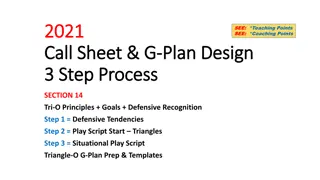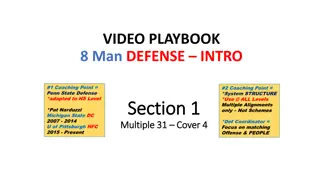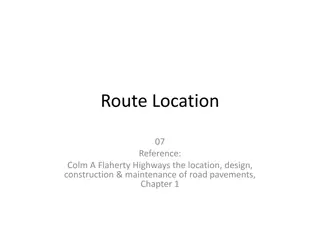Defensive Driving: Road Rage and Aggressive Driving Awareness
Learn about defensive driving techniques to identify and react to road rage and aggressive driving behaviors. Topics include road rage causes, safe following distances, reacting to driving problems, and handling aggressive drivers. Understand the progression of aggressive driving actions and how extreme cases lead to road rage. Discover tips on preventing collisions and how to handle road rage situations effectively.
Download Presentation

Please find below an Image/Link to download the presentation.
The content on the website is provided AS IS for your information and personal use only. It may not be sold, licensed, or shared on other websites without obtaining consent from the author.If you encounter any issues during the download, it is possible that the publisher has removed the file from their server.
You are allowed to download the files provided on this website for personal or commercial use, subject to the condition that they are used lawfully. All files are the property of their respective owners.
The content on the website is provided AS IS for your information and personal use only. It may not be sold, licensed, or shared on other websites without obtaining consent from the author.
E N D
Presentation Transcript
DEFENSIVE DRIVING CHAPTER 5
PREVIEW CHAPTER 5 TOPICS You will be able to identify defensive driving information. 1. Road rage & driving distractions 2. Safe distance & following distance 3. Road conditions 4. Driving situations 5. Reacting to driving problems 6. Vehicle failure
OBJ: IDENTIFY AGGRESSIVE DRIVING BEHAVIORS AND DEMONSTRATE HOW YOU WOULD REACT TO AGGRESSIVE DRIVING Do now What actions could lead to road rage?
ANSWER Extreme cases of aggressive driving leads to road rage
PREVENT A COLLISION Accident prevention formula 1. Be alert 2. Be prepared 3. Act in time
AGGRESSIVE DRIVING Progression of unlawful driving actions including Altering the speed of a vehicle making improper lane changes disregarding traffic control devices failing to yield the right of way tailgating. Extreme cases of aggressive driving leads to road rage
ROAD RAGE Road rage- motorists lose their tempers or become frustrated because of a traffic disturbance more likely to cause a collision Examples: run stop signs & red lights, speed, tailgate, weave through traffic, pass illegally, improper/unsafe lane changes, make hand or face gestures, scream, honk horns, flash high beams, *cause collision *Have you ever experiences someone with road rage? Christmas Vacation
HOW TO HANDLE ROAD RAGE Do not react to insults, gestures, or other rude behavior. Do not respond in any way, either verbally or behaviorally, other than to back off and give the aggressive driver room to "leave." Stay away from drivers who are speeding or exhibiting another form of anxiety. Do not engage the aggressive driver do not establish eye contact. Do not try to gain the upper hand and never try to teach someone a "lesson."
ACTIVITY Get into groups of 5 Discuss and write a situation that can result in a driver becoming aggressive/angry based off of the examples we discussed. Show different degrees of anger by two or more drivers. Act out in front of class. The rest of the class will discuss how they could respond in that situation.
SUMMARIZER In extreme cases, an aggressive driver might do what?
ANSWER Cause an accident
DRIVE RIGHT Get with learning partner #7 Read pages 106-111 in Drive Right Answer questions #1-5 on page 111
OBJ: IDENTIFY DRIVING DISTRACTIONS Do now What are some things that could lead to distracted driving?
ANSWER Adjusting the radio Using a cellular phone or any other electronic device Eating
COMPLETE THE DISTRACTED DRIVING SAFETY QUIZ Take out a blank piece of paper and a pen Write down your answers in order for the questions DISTRACTED DRIVING SLIDE-page 4 I will be at your house after I am finished with work tonight. My boss kept me late. Sorry. I m leaving now
DISRACTION ACTIVITY 1. Take out your cell phone 2. Watch the following 30 sec. commercial: M & M's 3. You will text/iMessage the following message into your phone/while watching: I will be at your house after I am finished with work tonight My boss kept me late. Sorry. I m leaving now
COMMERCIAL QUESTIONS ANSWER ON YOUR NOTE SHEET 1. What did the mom find in the wash? 2. What color was it? 3. What were the two kids eating? 4. What color M & M was sitting on the island? 5. What color is the mom s laundry basket? 6. What color towel was the naked M & M wearing?
M&M COMMERCIAL ANSWERS 1. Red stained clothes 2. Red 3. M & M s 4. Yellow 5. White 6. White red stripes
DISTRACTIONS *In many cases, collisions are caused by a distracted motorist Lighting a cigarette Fasten seatbelt Reaching to grab something Getting $ for tolls Watching children or pets in vehicle Reading Eating Adjusting mirror Cell phones Adjusting radio Applying makeup Shaving Robbinsville
DISTRACTIONS Discuss with elbow partner 1.Have you ever seen a distracted driver on the road? 2.Have you ever been in the car with a distracted driver? Cell phone/electronics? Talking? Children/pets in vehicle? Reaching to grab something?
DISTRACTIONS VIDEOS Boy singing Don't Text and Drive - Facebook Texting PSA graphic ATT - It Can Wait *Texting while driving is involved in 200,000+ vehicle crashes each year, often causing injuries and deaths.* State Farm Steer Clear Pt. 2 Steer Clear
OBJ: IDENTIFY ROADWAY CONDITIONS AND DRIVING SITUATIONS Do now When are road surfaces the MOST slippery?
ANSWER The first few minutes of a rainfall Why? Moisture mixes with oil and dust that hasn t been washed away
HIGHWAY HYPNOSIS Highway hypnosis Trance like state that may be avoided by not looking at any one thing for more than a few seconds How to avoid it? Not looking at any one object Can not drive well and reaction time is reduced A tired driver can be as dangerous as a drunk driver *Maggie's Law* 2003 illegal to knowingly drive a vehicle while impaired by lack of sleep
HIGHWAY HYPNOSIS Drowsy driving who is at risk? Sleep deprived Driving long distances Driving through the night Taking medicine Driving alone Driving long rural roads Shift workers Commercial drivers
COMMUNICATING Communicate with motorists by all available means and signals. Always stay in the lane that shows where you intend to turn. Turn signals Hand signals Eye contact Horn Flip head lights quickly
SAFE DISTANCE One Car Length Method- For every 10mph you are traveling, leave one car length between you and the car you are following (Ex. 5 car lengths if traveling at 50 mph Three Second Rule- Keep 3 seconds of distance between you and the car you are following. 1. Pick a fixed object ahead of you. 2. When the car in front of you passes that object begin counting. 3. If it takes at least 3 seconds for you to reach that object you are at a safe following distance.
FOLLOWING DISTANCE Road Condition Ideal Wet Gravel Packet snow Ice 20 mph 30 mph 40 mph 50 mph 2 car lengths 4 car lengths 4 car lengths 6 car lengths 12 car lengths 3 6 6 9 18 4 8 8 12 5 10 10
ROAD CONDITIONS WET ROADS Drive more slowly Road surfaces are the MOST slippery the first few minutes of a rainfall When driving through puddles expect your car to pull in the direction the puddle is on. Pump your brakes after driving through one to dry them out. After driving through a puddle test your brakes
ROAD CONDITIONS HYDROPLANING When your tires ride on a film of water and lose contact with the road surface. Begins to occur at 35 mph Between 35 and 55 mph the tires begin to lose contact. At reaching 55+ mph tires lose all contact with the road. In a heavy rainstorm, try to drive on the highest point of the road hydroplaning
ROAD CONDITIONS SNOW AND ICE Potential dangers include longer night hours, fog, rain, snow, sleet and ice. Necessary precautions include: a) Allowing a proper warm up. b) Remove all ice and snow from your car (you may be liable if ice falls off of your car and causes either and injury or property damage). c) Get the feel of the road- start slow d) Snow tires (studded tires legal from (Nov. 15th April 1st). e) When starting to move keep engine speed slow- spinning wheels will cause you to skid. ABS- keep foot on brake pedal and don t pump brakes Conventional- firm, steady pressure on the brake pedal.
OTHER ROAD CONDITIONS REDUCED VISIBILITY Frost/Ice- scrape, wipe all windows, turn on defroster Fog- use low beams; use pavement markings and other vehicle lights as guides. Sun Glare- adjust sun visors or wear sun glasses; slow down 1. 2. 3. NO Matter What the REASON- STOP If you cannot see!!
OTHER ROAD CONDITIONS NIGHT DRIVING 90 % of driving decisions are based on what a motorist sees while driving. At night, a motorists vision is reduced. To drive safely at night Slow down and drive within the range of the vehicles headlights (if you need to suddenly break, you have enough time to do so) Don t over drive your headlights (350 for low beams/500 for high beams). Be sure you can stop within the distance you can see ahead
DRIVING SITUATIONS CITY DRIVING More traffic and distractions; try to look at least 12 sec. ahead (about 1 city block). Drive more slowly and be careful for pedestrians HIGHWAY DRIVING Faster speeds/less time to react; easier to lose focus (including highway hypnosis) SECONDARY ROAD DRIVING- hills, bridges, hazards Usually only 2 lanes; sharper turns and hills; limited sight; animals.
DRIVING SITUATIONS RESIDENTIAL More children/pedestrians are present; delivery vehicles. CONSTRUCTION Lane changes; slow moving vehicles; detours, temporary traffic devices including flagmen. **fines doubled**
SUMMARIZER To maintain the proper following distance when driving, you should remain how far behind the vehicle in front of you?
ANSWER At least 3 seconds
ACTIVITY Complete Road Rage raps
OBJ: IDENTIFY COLLISIONS AND REACTING TO DRIVING PROBLEMS Do now: Your car has gone into a skid. What do you do?
ANSWER Take foot off gas turn the wheel in the direction the rear of the car is going (into the skid)
REACTING TO DRIVING PROBLEMS IGNITION SYSTEM A motorist in an emergency situation many attempt to turn off the vehicle while it s still in motion. Never turn the ignition to lock position while the vehicle is in motion. The steering will lock and the motorist will lose control of the vehicle. Permits key removal only when in park
REACTING TO DRIVING PROBLEMS SKIDS CAUSES? Sudden turns / lane changes Hard braking More common on wet and/or icy roads HOW DO YOU HANDLE IT? Foot off of accelerator Steer in direction rear end is heading (into the skid) Look in the direction you want to go *If the rear end of the vehicle starts to slide, take your foot off the gas pedal *A vehicle may spin if the steering wheel is quickly turned away from the direction of the skid
REACTING TO DRIVING PROBLEMS EMERGENCY STOPS KEEP SEVERAL BASIC POINTS IN MIND Pull over as far as you can Make yourself and car as visible as possible PULLING OVER Paved shoulder: Allows you to pull over at or near traffic speed Unpaved shoulder: Slow to a safe speed before pulling over!
REACTING TO DRIVING PROBLEMS EMERGENCY STOPS VISIBILITY! Turn on lights/emergency flashers Raise hood Flares/warning instruments Tie a white cloth to the antenna or left door handle as a signal, if help is needed MAKE YOURSELF AS VISIBLE AS POSSIBLE!
REACTING TO DRIVING PROBLEMS RUNNING OFF THE PAVEMENT If a vehicles wheel s drift onto the shoulder of the road, do not try to turn back onto the pavement right away. This could throw the vehicle off balance. Stay on shoulder Gradually slow down At 25 MPH or less, steer turn towards roadway
REACTING TO DRIVING PROBLEMS CAR FIRES Most caused by short circuits in the electrical system never try to put out Get out Get away Call for help
REACTING TO DRIVING PROBLEMS PLUNGING INTO WATER Vehicles will float 3-10 minutes Open windows immediately (escape while vehicle is still floating through open window) Sinks nose (front end) first Always wear a seatbelt! Reduce risk of being knocked out unconscious
VEHICLE FAILURE BRAKE FAILURE Conventional or drum disk shift to lower gear and pump the brake pedal fast and hard several times (this could build up enough pressure to stop the vehicle) If that doesn t work, the parking brake should be used while holding the brake so the wheels lock up and the vehicle will skid.
VEHICLE FAILURE TIRE BLOWOUT Grip the steering wheel Keep vehicle straight while gradually slowing down Remove foot from gas and don t use the brakes Vehicle should coast to a stop
